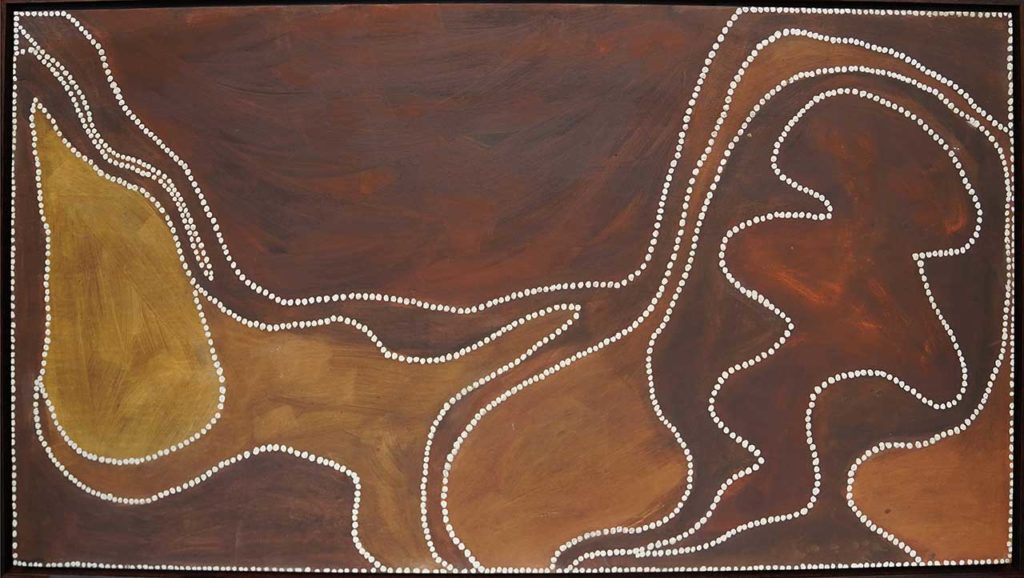Rover Thomas Masterpiece Goes To Japanese Museum
In this article Japingka's Ian Plunkett tells the story of how a Japanese museum came to buy a major work by the late Rover Thomas.
The Approach
Towards the end of last year, a major museum in Japan approached us about the works of the late great Rover Thomas, a Kimberley artist. He's a well-known ochre painter. His work is held in many major institutions around the world. In Australia, you'll find his works in the National Gallery of Australia and the State collection at the Art Gallery of Western Australia. The museum team was asking for our assistance. They knew that we had some work by Rover Thomas, and they were requesting our help to find other paintings for sale by that artist.
We did some research and showed them the other works we found. These were on the secondary market, meaning they were works held in private collections for decades and were now offered again for resale. This secondary market is how Japingka Gallery came to have our four works. There are very few Rover Thomas works on the market at any time.
The Conversation
The museum team had a look and said, "Could we send them details on everything we had on Rover Thomas?" At the time, we had four stunning large and medium-sized works by Rover. These were painted from around 1985, when Rover was probably at the peak of his powers and producing some of the best work of his career.
The museum staff were immediately impressed by the largest painting. I think this painting is up there amongst Rover Thomas's very best works. It was a painting on board in traditional natural ochre pigments. It is about Bedford Downs Station, where Rover had worked as a cattleman. It's an aerial view of the country around there, like a map.
The museum people were blown away by it. That was by no means the end of the process. There were still many steps to go through. We're selling to a major museum, so there were condition reports, high-resolution images, provenance records and other detailed procedures to follow.
The Museum
This particular museum has a stunning collection of works from all around the world. They're not just exhibiting Japanese art. They have works by Pierre-Auguste Renoir, Caro, Pollock and Picasso. Theirs is a major collection of the highest world standard. The curators wanted some Indigenous art to add to their collection. They knew of Rover Thomas but didn't know much in detail about him. They did know that he was one of the most highly respected contemporary Indigenous artists.
The museum was pleased to be able to secure this particular piece. It took many months of back and forth of photos, discussions and condition reports. The painting was shipped towards the end of last year. This handover would allow the museum to inspect the work and see if it lived up to their expectations. It more than lived up to their expectations! The museum was delighted to have such a work of such high quality by such a well-renowned artist in their collection. It will take pride of place in its international collection and will go on show soon. We're just proud to have facilitated this. The Japanese public can view and enjoy this work by one of the greatest Indigenous artists that Australia has ever produced.
The Japingka Gallery Collection
The sale of this Rover Thomas work reflects the quality of the artworks at Japingka Gallery. They are of museum quality. That's in part due to the fact that the works are ethically sourced and produced, but also a testament to our 35 years of experience in the industry. We know what to look for when it comes to assessing Indigenous art. We have a depth of experience in evaluating quality, authenticity and provenance. Works in our gallery could grace any collection of the world. We still have three of those Rover Thomas's paintings available in our collection. We're proud to have them. But then again, we've got 3,500 other artworks that are also of high quality.
How Japingka Choose Art
We handpick everything that we choose to show in the gallery. Our approach starts with the most critical question. Is the art ethically sourced? Secondly, we assess the quality of the artwork. All art we display appeals to both of us, as the directors. Otherwise we don't want to show the work in the gallery.
We are proud of the collection we have accumulated over 35 years and that the quality is being recognised in Australia and overseas. We have sold works for the National Gallery of Victoria and the Art Collection at Parliament House in Canberra. We've also sold work to overseas collections like the Queen's Royal Collection and other major museums in America and elsewhere.
Is Quality Aboriginal Art All Expensive?
Does this mean we only sell expensive art? Not at all. Price is not necessarily a guide to the quality of an artwork. It's just one of the guides. You can get stunning artwork from a highly regarded artist, but it doesn't necessarily have to cost a fortune. Sometimes the artist is at the beginning of their career. Perhaps they're not as well known outside of the art industry. The cost of the works relates to the demand for art by that artist. During an artist's lifetime, demand for their work will fluctuate. You can sometimes get exceptional exquisite artwork for relatively little money.
It is easy to explore the Japingka Gallery collection. You can also search through our 3,500 artworks by price, colour palette, artist, medium or subject matter. This search facility makes it easier to find something you love. You can have something exceptional and feel confident that the work is well documented and guaranteed.

